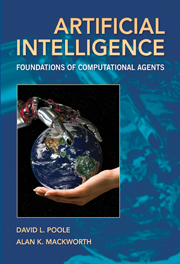Book contents
- Frontmatter
- Contents
- Preface
- I Agents in the World: What Are Agents and How Can They Be Built?
- II Representing and Reasoning
- III Learning and Planning
- 7 Learning: Overview and Supervised Learning
- 8 Planning with Certainty
- 9 Planning Under Uncertainty
- 10 Multiagent Systems
- 11 Beyond Supervised Learning
- IV Reasoning About Individuals and Relations
- V The Big Picture
- A Mathematical Preliminaries and Notation
- Bibliography
- Index
11 - Beyond Supervised Learning
from III - Learning and Planning
- Frontmatter
- Contents
- Preface
- I Agents in the World: What Are Agents and How Can They Be Built?
- II Representing and Reasoning
- III Learning and Planning
- 7 Learning: Overview and Supervised Learning
- 8 Planning with Certainty
- 9 Planning Under Uncertainty
- 10 Multiagent Systems
- 11 Beyond Supervised Learning
- IV Reasoning About Individuals and Relations
- V The Big Picture
- A Mathematical Preliminaries and Notation
- Bibliography
- Index
Summary
Learning without thought is labor lost; thought without learning is perilous.
Confucius (551 BC – 479 BC), The Confucian AnalectsThis chapter goes beyond the supervised learning of Chapter 7. It covers learning richer representation and learning what to do; this enables learning to be combined with reasoning. First we consider unsupervised learning in which the classifications are not given in the training set. This is a special case of learning belief network, which is considered next. Finally, we consider reinforcement learning, in which an agent learns how to act while interacting with an environment.
Clustering
Chapter 7 considered supervised learning, where the target features that must be predicted from input features are observed in the training data. In clustering or unsupervised learning, the target features are not given in the training examples. The aim is to construct a natural classification that can be used to cluster the data.
The general idea behind clustering is to partition the examples into clusters or classes. Each class predicts feature values for the examples in the class. Each clustering has a prediction error on the predictions. The best clustering is the one that minimizes the error.
Example 11.1 A diagnostic assistant may want to group the different treatments into groups that predict the desirable and undesirable effects of the treatment. The assistant may not want to give a patient a drug because similar drugs may have had disastrous effects on similar patients. […]
Information
- Type
- Chapter
- Information
- Artificial IntelligenceFoundations of Computational Agents, pp. 451 - 488Publisher: Cambridge University PressPrint publication year: 2010
